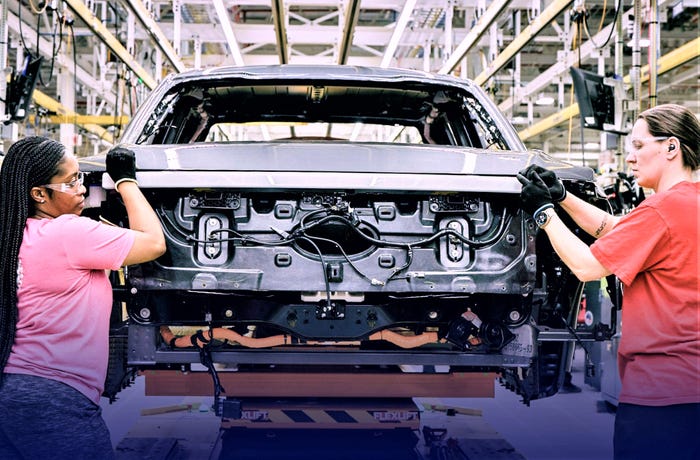UAW President Fain Fighting for More Than MoneyUAW President Fain Fighting for More Than Money
“Our members are working 60, 70, even 80 hours a week just to make ends meet – that’s not a living,” UAW President Shawn Fain says. “That's barely surviving, and it needs to stop.”
August 4, 2023

WAYNE, MI – Standing outside the sprawling Ford assembly plant in this Detroit suburb, UAW President Shawn Fain and Vice President Chuck Browning, head of the union’s Ford Dept., get an earful from union members filing into the plant for the second shift.
Not surprisingly, several say they are expecting more money in the next contract. But some also plead for more time off from the grueling work on the assembly line.
“Time off is a big issue,” Browning tells one of the members, who stops to complain about Ford’s management dictating when they can and cannot take a day off. Browning notes additional time off also was a key issue when the union walked out at John Deere in the fall of 2021.
Fain, for his part, says he is sympathetic to workers’ pleas as he attempts to rewrite the 144,000-member union’s labor contracts with the manufacturing operations of Ford, General Motors and Stellantis. Negotiations began about two weeks ago as the UAW’s current contracts expire Sept. 14.
“If this awful pandemic (taught) us anything, it’s that there’s more to life than just work. It’s not enough to just survive. We should all have a right to thrive,” Fain notes during a recent Facebook live session.
To that end, Fain says the UAW intends to fight for more paid time off. While responding to questions from the online chat, he says he would favor a shorter work week of 32 hours instead of 40 hours. In some parts of the world, the work week has been cut to 30 hours with full pay, he adds.
“Our members are working 60, 70, even 80 hours a week just to make ends meet – that’s not a living,” Fain says, noting workers often must miss out on family gatherings or church events. They don’t have time for community activities, Little League games or hobbies. “That's barely surviving, and it needs to stop,” he says.
Fain describes the union’s demands as “ambitious and audacious,” but says they are necessary to reverse the downward spiral of auto workers, which began nearly two decades ago.
Since 2007, says Fain, UAW members have not only lost cost-of-living protection but the starting wage also has been reduced substantially. It now takes eight years to reach the top of the pay scale for an assembler, which is currently $32, he says. Before 2007, it took just three years and workers would grow into a defined-benefit pension plan.

Ford assembly line 3
For new workers hired after the contract was signed, the defined benefit also was eliminated.
Most new hires now start out as temporary workers making $16 per hour, says the union. But inflation has eroded the current starting wage for full-time assemblers of $19.60 per hour. If cost-of-living increases had been in place the current starting wage at Ford, GM and Stellantis would be $28.68, Fain notes.
The current UAW contracts also created multiple “tiers,” so anyone employed at different component plants or in warehouses is paid less than the $32 per hour assemblers make in the company’s big factories.
The International Brotherhood of Teamsters’ tentative agreement with United Parcel Service eliminates the tiered wage structure for full-time employees, Fain says.
Fain notes Detroit’s three automakers have closed 65 plants in the past two decades, placing an enormous strain on hourly workers and the communities in which they live. The union wants to negotiate the right to strike anytime a company threatens to shut a plant, he says.
When a plant is closed, workers are left with three options: They may retire if they are eligible, they can uproot their families and move to another community, or they can quit, Fain says, adding, “That’s it.”
To deter future plant closings the UAW is proposing to pay workers for community service like the jobs banks of the 1990s, which critics derided as an elaborate form of featherbedding.
At the same time, Fain points out, industry executives are making huge salaries and using company-funded stock buybacks to further enrich themselves.
GM CEO Mary Barra made $29 million in 2022, says Fain. It would take a worker at the Ultium Cells plant in northeast Ohio 16 years to make what Barra makes in one week, he says.
Fain emphasizes he is not the author of the union’s economic demands. “I am telling them these are the members’ demands.”
Says Arthur Wheaton, a labor expert from Cornell University: “The key takeaways from Shawn Fain’s live Facebook (session)…was the importance of representing the lower levels of the organization. Definitely a divide (exists) between CEO and executive compensation and the very low wages for part-time, new hires, temps and workers from GM Components Holding or battery plants.
“Fairness, equity and work-life balance are important themes in these negotiations as they were (for the) Teamsters at UPS as well,” says Wheaton. “The labor market is in the union’s favor and the cost of living has intensified demands for payback of lost wages and benefits.”
“Bargaining is never easy, but the newly elected leadership teams seem to be blazing a bold trail,” Wheaton says.
Automakers’ response to the UAW’s demands is restrained.
“Stellantis and the UAW have a shared interest in these negotiations: securing the future of our 43,000 employees and their families. We have been clear from the start that we are not seeking a concessionary agreement.
“As we have done for more than 70 years, we will work constructively and collaboratively with the UAW to find solutions that will result in a contract that is competitive in the global market, responsibly addresses employee concerns and meets the needs of our customers,” Stellantis says.
Says Ford: “Ford is proud to build more vehicles in America and employ more UAW-represented hourly workers in America than any other automaker. We look forward to working with the UAW on creative solutions during this time when our dramatically changing industry needs a skilled and competitive workforce more than ever.”
In a letter to shareholders, GM’s Barra says: “We have a long history of negotiating fair contracts with both unions (the UAW and Unifor, representing Canadian auto workers) that reward our employees and support the long-term success of our business. Our goal this time will be no different.”
About the Author
You May Also Like